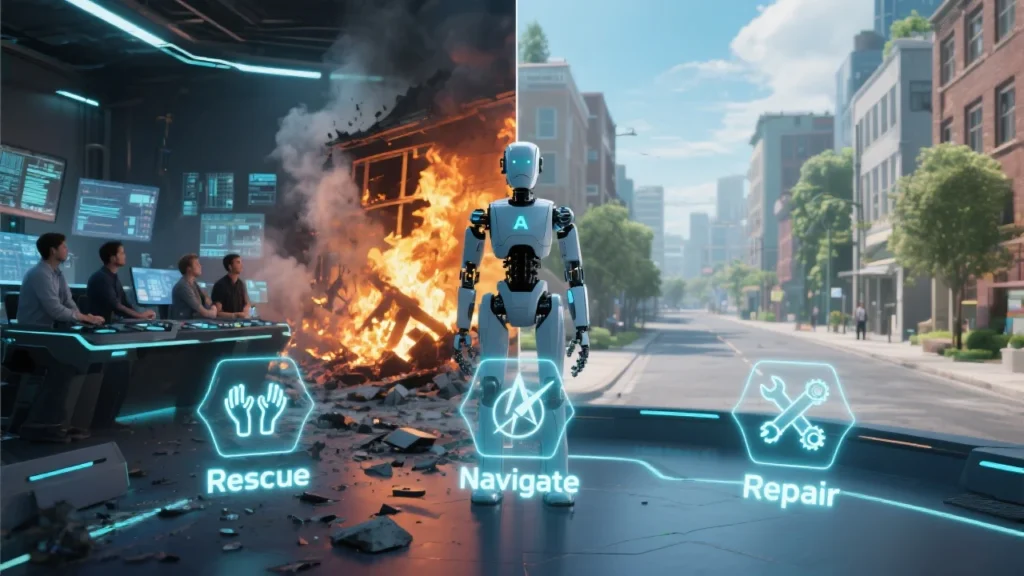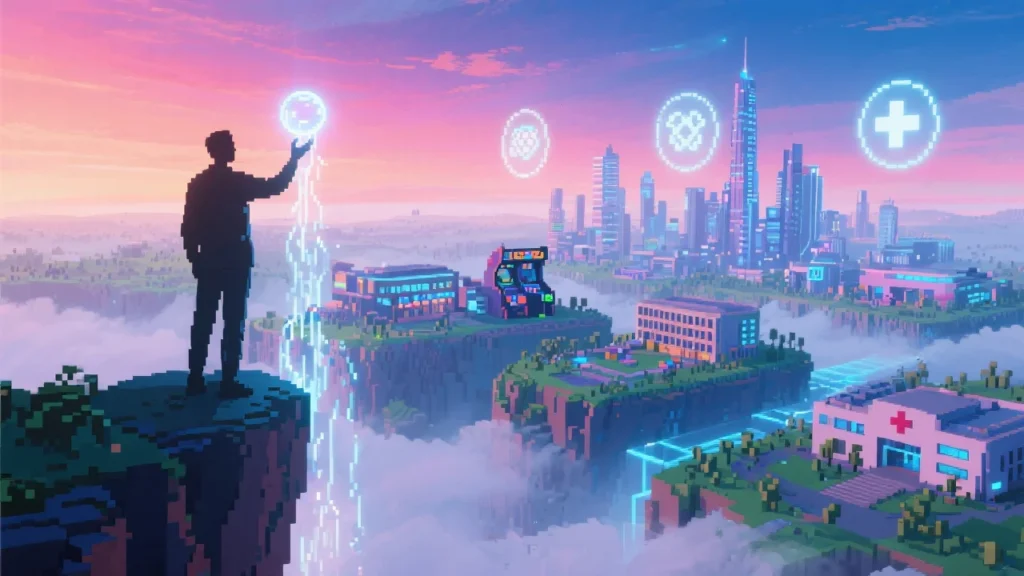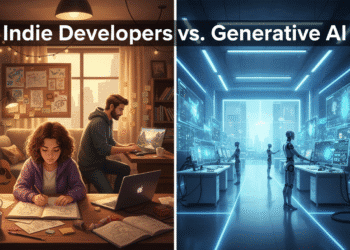The gaming industry just witnessed something extraordinary. Google DeepMind dropped a bombshell that could fundamentally change how we think about virtual worlds. Their latest creation, Genie 3, isn’t just another AI model it’s a glimpse into a future where entire video game universes spring to life from nothing more than a text prompt.
This isn’t science fiction anymore. It’s happening right now.
What Makes Genie 3 a Game-Changer?
Picture this: You type “Create a medieval castle surrounded by a moat with dragons flying overhead.” Within seconds, you’re exploring that exact world in real-time. You can walk around, interact with objects, and watch as the environment responds to your every move. The dragons soar through the sky. The water in the moat ripples. Everything feels alive.
That’s Genie 3 in action.
Unlike traditional video games that require months or years of development, Genie 3 generates these interactive 3D environments on the fly. We’re talking about worlds that maintain visual consistency for multiple minutes a massive leap from its predecessor, Genie 2, which could barely manage 10-20 seconds of coherent interaction.
The technical specs are impressive too. These worlds run at 720p resolution and 24 frames per second. That’s smooth enough for genuine gameplay experiences, not just tech demos.
Breaking Down the Technical Marvel
Here’s where things get really interesting. Genie 3 doesn’t rely on pre-built 3D assets or traditional game engines. Instead, it generates each frame autoregressively, considering up to a minute of previous environmental details. Think of it as having a photographic memory that remembers exactly where you placed that sword on the table, even if you turn away and come back later.
This approach solves one of the biggest problems with AI-generated content: consistency. Previous models would create worlds that morphed and changed unpredictably. Objects would disappear. Textures would shift. The experience felt more like a fever dream than a coherent virtual space.
Genie 3 changes all that. The model maintains what Google calls “visual memory” for about a minute. Paint on a wall stays put. Writing on a chalkboard remains legible. The world feels solid and reliable.
Real-Time Interaction: The Holy Grail of AI Gaming
What sets Genie 3 apart isn’t just its ability to create worlds it’s how you can interact with them. The model supports what DeepMind calls “promptable world events.” Want to change the weather? Just ask. Need to add new characters? Type it in. The AI responds in real-time, adapting the world based on your commands.
This level of interactivity represents a fundamental shift. Traditional video games follow predetermined rules and scripts. Genie 3 creates dynamic, responsive environments that can adapt to virtually any scenario you can imagine.
The implications are staggering. Educational simulations could recreate historical events with perfect accuracy. Training programs could generate countless scenarios for emergency responders. Entertainment could become truly personalized, with each player experiencing unique adventures tailored to their preferences.
From Ancient Knossos to Flying Islands: The Creative Possibilities
The range of environments Genie 3 can create is mind-boggling. The model handles everything from photorealistic landscapes with dynamic weather effects to fantastical realms featuring portals and floating islands. It can reconstruct historical locations like ancient Venice or create entirely imaginary worlds populated with animated creatures.
During demonstrations, researchers showed off worlds with lava flows, wind effects, and rain systems that all behaved naturally. The AI doesn’t just paint pretty pictures it understands physics well enough to create believable environmental interactions.
One particularly impressive example showed ancient gates with trees that remained consistently positioned as the camera moved around the scene. This kind of spatial awareness was nearly impossible for previous AI models to maintain.
Training Ground for the Next Generation of AI

Beyond gaming and entertainment, Genie 3 serves a more ambitious purpose: training autonomous AI agents. DeepMind is already using the platform to test their SIMA agent, which completes tasks independently within these generated worlds.
This represents a paradigm shift in AI development. Instead of training agents on static datasets, researchers can now create unlimited scenarios for testing and learning. The AI agents can explore, make mistakes, and adapt in safe, controlled environments that mirror real-world complexity.
The potential applications extend far beyond gaming. Autonomous vehicles could train in countless traffic scenarios. Robots could practice complex tasks in simulated environments. Medical AI could explore treatment options in virtual patient scenarios.
The Technology Behind the Magic
Genie 3’s approach differs fundamentally from traditional 3D modeling techniques. Instead of relying on methods like NeRF or Gaussian splatting, which require pre-existing 3D data, Genie 3 generates environments directly from text descriptions. The consistency emerges from the simulation itself, not from programmed rules.
This data-driven approach aligns with what AI researchers call the “bitter lesson” the idea that general methods leveraging computation and data ultimately prove more effective than approaches that incorporate human knowledge. Genie 3 embodies this philosophy, learning world physics and visual consistency from vast amounts of training data rather than explicit programming.
The model’s architecture allows it to maintain coherence across extended interactions while responding to user inputs in real-time. This balance between stability and responsiveness represents a significant technical achievement.
Current Limitations and Future Potential
Despite its impressive capabilities, Genie 3 isn’t perfect. The model currently supports only a few minutes of continuous interaction. Agent actions remain somewhat restricted. Multi-agent simulations aren’t yet reliable. Real-world locations lack proper georeferencing, and readable text only appears when specifically included in prompts.
These limitations reflect the early stage of the technology. But the trajectory is clear. Each iteration of the Genie series has dramatically improved upon its predecessor. If this trend continues, we could see hour-long interactive experiences within the next few years.
The Road to “Game Engine 2.0”
NVIDIA’s Director of AI, Jim Fan, sees Genie 3 as a preview of what he calls “game engine 2.0.” He envisions a future where all the complexity of traditional game engines like Unreal Engine gets absorbed into AI models. Instead of explicit 3D assets and complex programming, developers would work with “attention weights” that directly animate pixels based on controller inputs.
This vision suggests game development could evolve into sophisticated prompt engineering. Developers would describe their vision in natural language, and AI would handle the technical implementation. The creative process would become more accessible while potentially more powerful.
Limited Access and Responsible Development
Currently, Genie 3 remains in a limited research preview. Only a small group of academics and creators have access to the system. Google DeepMind is taking a cautious approach, wanting to understand potential risks and develop appropriate safeguards before wider release.
This measured rollout reflects growing awareness of AI’s potential impact. The ability to generate convincing virtual worlds raises questions about misinformation, deepfakes, and the blurring line between reality and simulation. Responsible development requires careful consideration of these implications.
The Bigger Picture: A Step Toward AGI
DeepMind positions Genie 3 as more than just a gaming tool. The company sees world models as a crucial stepping stone toward Artificial General Intelligence (AGI). By creating systems that can simulate and understand complex environments, researchers are building the foundation for more general AI capabilities.
This aligns with recent research from DeepMind scientists Richard Sutton and David Silver, who advocate for moving away from systems trained on static human data toward agents that learn from their own experiences in simulated worlds. Genie 3 represents a significant step in this direction.
What This Means for the Future

The implications of Genie 3 extend far beyond gaming. We’re looking at a technology that could revolutionize education, training, entertainment, and AI development itself. The ability to generate interactive, consistent virtual worlds on demand opens possibilities we’re only beginning to explore.
As the technology matures and becomes more widely available, we can expect to see applications in fields ranging from architecture and urban planning to therapy and social interaction. The line between the physical and digital worlds continues to blur, and Genie 3 represents a significant push in that direction.
The future of virtual worlds isn’t just about better graphics or more realistic physics. It’s about creating spaces that respond intelligently to human needs and desires. Genie 3 brings us one step closer to that vision, where the only limit to virtual experiences is our imagination.









